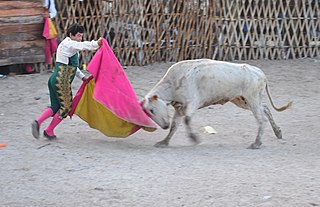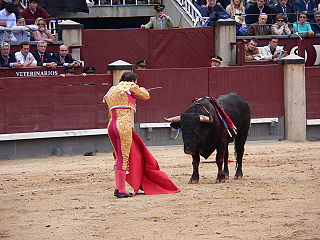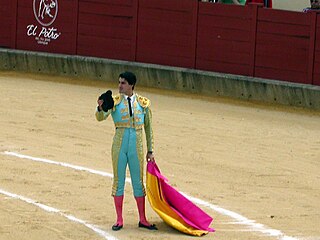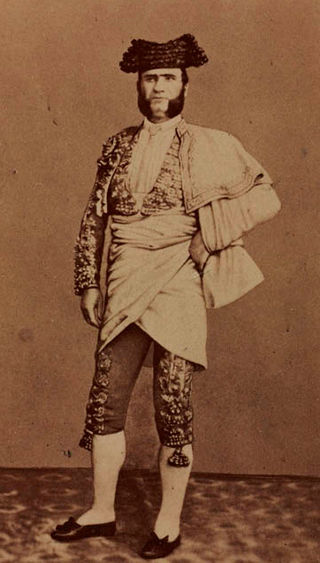
A bullfighter is a performer in the activity of bullfighting. Torero or toureiro, both from Latin taurarius, are the Spanish and Portuguese words for bullfighter and describe all the performers in the activity of bullfighting as practised in Spain, Portugal, Mexico, Peru, France, Colombia, Ecuador, Venezuela and other countries influenced by Portuguese and Spanish culture. The main performer and leader of the entourage in a bullfight, and who finally kills the bull, is addressed as maestro (master), or with the formal title matador de toros. The other bullfighters in the entourage are called subalternos and their suits are embroidered in silver as opposed to the matador's gold. They include the picadores, rejoneadores, and banderilleros.

Pedro Romero Martínez was a legendary bullfighter from the Romero family in Ronda, Spain.

A montera is the hat traditionally worn by many males and females in the folk costumes of the Iberian peninsula. It has come to name also but not exclusively the ones used by bullfighters, introduced to the event in 1835 by Francisco "Paquiro" Montes as accompaniment to the traje de luces, or "suit of lights".

A pollera is a Spanish term for a large one-piece skirt used mostly in traditional festivities and folklore throughout Spanish-speaking Latin America. Polleras are made from different materials, such as cotton or wool and tend to have colorful decorations. Most of the decorations are embroidered, flowers and regional animals are among the most common designs found in polleras.

Francisco Romero (1700–1763) was a significant Spanish matador. He reputedly introduced the famous red cape (muleta) into bullfighting in around 1726.

El Fandi is statistically one of the most skilled matadors in the world. Currently, he is ranked number one among all bullfighters in Spain.

Spanish-style bullfighting is a type of bullfighting that is practiced in Spain, Mexico, Colombia, Ecuador, Venezuela, Peru, as well as in parts of southern France and Portugal. This style of bullfighting involves a physical contest with humans attempting to publicly subdue, immobilize, or kill a bull. The most common bull used is the Spanish Fighting Bull, a type of cattle native to the Iberian Peninsula. This style of bullfighting is seen to be both a sport and performance art. The red colour of the cape is a matter of tradition – bulls are color blind. They attack moving objects; the brightly-colored cape is used to mask blood stains.

Antonio Cayetano Rivera Ordóñez is a Spanish torero or 'bullfighter'.

Bullfighting is a physical contest that involves a bullfighter attempting to subdue, immobilize, or kill a bull, usually according to a set of rules, guidelines, or cultural expectations.
Le petit picador jaune is an oil on wood painting by the Spanish artist Pablo Picasso, which he created in 1889 at the age of eight. It is considered to be the earliest known surviving work by the artist. The painting is a colourful representation of a Spanish bullfight, a subject which Picasso repeatedly returned to throughout his career.

Julio Aparicio Díaz, also known as Julito Aparicio, is a Spanish bullfighter from Seville. Aparicio made his public début in bullfighting at the age of fourteen in 1984. He was confirmed as a torero, or matador, in 1994.

The pañuelo or alampay is a Filipino lace-like embroidered neck scarf or shawl worn around the shoulders over the camisa (blouse). They were square-shaped and were folded in half into a triangle when worn. Pañuelos are the direct predecessors of the Manila shawl.

Bullfight is an 1824 oil painting by Goya owned since 1992 by the J. Paul Getty Museum. When the museum bought the painting at auction in 1992, it shattered the artist's previous auction record. This piece shows Goya’s favorite form of entertainment: the controversial contest of bullfighting.

The Plaza de toros La Montera is a bull ring in Los Barrios, a town in the province of Cádiz at the southern edge of Spain, close to the British territory of Gibraltar, was opened in 2000.

Mademoiselle V. in the Costume of an Espada is an 1862 oil-on-canvas painting by French artist Édouard Manet. The painting is in the collection of the Metropolitan Museum of Art, having been acquired in 1929. Manet exhibited the painting at the 1863 Salon des Refusés alongside Jeune Homme en costume de majo and Le Déjeuner sur l'herbe. It is often cited as an example of Manet's work being influenced by Spanish art.
Pablo Lozano Martín, commonly known as La Muleta de Castilla, was a Spanish bullfighter and fighting bull cattle rancher, owner of cattle raising Alcurrucén and "Hermanos Lozano".

The Plaza de Toros de Pontevedra (Spain) is the bullring of the Spanish city of Pontevedra and the only one in the autonomous community of Galicia. It has a capacity of 7,800 spectators and is classified as the second category of Spanish bullring. The current bullring replaced a wooden one dating from 1892, although the tradition of bullfighting in Pontevedra dates back to the 17th century.

Jesús Janeiro Bazán, better known as Jesulín de Ubrique, is a Spanish torero or bullfighter.
The alternativa ("alternative"), in Spanish-style bullfighting, is the act by which a novillero is authorized to be considered a torero, so that he can alternate in bullfighting with other bullfighters of the same category, both in bullfighting on foot and on horseback.

José Dámaso Rodríguez y Rodríguez, known as Pepete, was a Spanish bullfighter in the mid-19th century. He was the first notable matador known by this nickname.



















